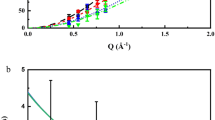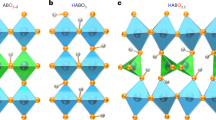Abstract
The environmental benefits of fuel cells have been increasingly appreciated in recent years. Among candidate electrolytes for solid-oxide fuel cells, yttrium-doped barium zirconate has garnered attention because of its high proton conductivity, particularly in the intermediate-temperature region targeted for cost-effective solid-oxide fuel cell operation, and its excellent chemical stability. However, fundamental questions surrounding the defect chemistry and macroscopic proton transport mechanism of this material remain, especially in regard to the possible role of proton trapping. Here we show, through a combined thermogravimetric and a.c. impedance study, that macroscopic proton transport in yttrium-doped barium zirconate is limited by proton–dopant association (proton trapping). Protons must overcome the association energy, 29 kJ mol−1, as well as the general activation energy, 16 kJ mol−1, to achieve long-range transport. Proton nuclear magnetic resonance studies show the presence of two types of proton environment above room temperature, reflecting differences in proton–dopant configurations. This insight motivates efforts to identify suitable alternative dopants with reduced association energies as a route to higher conductivities.
This is a preview of subscription content, access via your institution
Access options
Subscribe to this journal
Receive 12 print issues and online access
$259.00 per year
only $21.58 per issue
Buy this article
- Purchase on Springer Link
- Instant access to full article PDF
Prices may be subject to local taxes which are calculated during checkout




Similar content being viewed by others
References
Kreuer, K. D. Proton-conducting oxides. Annu. Rev. Mater. Res. 33, 333–359 (2003).
Yamazaki, Y., Hernandez-Sanchez, R. & Haile, S. M. High total proton conductivity in large-grained yttrium-doped barium zirconate. Chem. Mater. 21, 2755–2762 (2009).
Fabbri, E., Pergolesi, D. & Traversa, E. Materials challenges toward proton-conducting oxide fuel cells: A critical review. Chem. Soc. Rev. 39, 4355–4369 (2010).
Kreuer, K. D. Aspects of the formation and mobility of protonic charge carriers and the stability of perovskite-type oxides. Solid State Ion. 125, 285–302 (1999).
Islam, M. S., Slater, P. R., Tolchard, J. R. & Dinges, T. Doping and defect association in AZrO3 (A = Ca, Ba) and LaMO3 (M = Sc, Ga) perovskite-type ionic conductors. Dalton Trans. 3061–3066 (2004).
Norby, T., Wideroe, M., Glockner, R. & Larring, Y. Hydrogen in oxides. Dalton Trans. 3012–3018 (2004).
Matzke, T. et al. Quasielastic thermal neutron scattering experiment on the proton conductor SrCe0.95Yb0.05H0.02O2.985 . Solid State Ion. 86-88, 621–628 (1996).
Stokes, S. J. & Islam, M. S. Defect chemistry and proton-dopant association in BaZrO3 and BaPrO3 . J. Mater. Chem. 20, 6258–6264 (2010).
Björketun, M. E., Sundell, P. G., Wahnström, G. & Engberg, D. A kinetic Monte Carlo study of proton diffusion in disordered perovskite structured lattices based on first-principles calculations. Solid State Ion. 176, 3035–3040 (2005).
Björketun, M. E., Sundell, P. G. & Wahnström, G. Effect of acceptor dopants on the proton mobility in BaZrO3: A density functional investigation. Phys. Rev. B 76, 054307 (2007).
Karlsson, M. et al. Using neutron spin-echo to investigate proton dynamics in proton-conducting perovskites. Chem. Mater. 22, 740–742 (2010).
Braun, A. et al. Proton diffusivity in the BaZr0.9Y0.1O3−δ proton conductor. J. Appl. Electrochem. 39, 471–475 (2009).
Karlsson, M. et al. Quasielastic neutron scattering of hydrated BaZr0.90A0.10O2.95 (A = Y and Sc). Solid State Ion. 180, 22–28 (2009).
Oriani, R. A. The diffusion and trapping of hydrogen in steel. Acta Metall. 18, 147–157 (1970).
Maier, J. Physical Chemistry of Ionic Materials 177–200 (Wiley, 2005).
Kreuer, K. D. et al. Proton conducting alkaline earth zirconates and titanates for high drain electrochemical applications. Solid State Ion. 145, 295–306 (2001).
Björketun, M. E., Sundell, P. G. & Wahnström, G. Structure and thermodynamic stability of hydrogen interstitials in BaZrO3 perovskite oxide from density functional calculations. Faraday Discuss. 134, 247–265 (2007).
Buannic, L., Blanc, F., Hung, I., Gan, Z. H. & Grey, C. P. Probing the local structures and protonic conduction pathways in scandium substituted BaZrO3 by multinuclear solid-state NMR spectroscopy. J. Mater. Chem. 20, 6322–6332 (2010).
Buannic, L. Solid State NMR Study of Protonic Conductors for Applications As Electrolyte Materials in Solid Oxide Fuel Cells PhD thesis (State Univ. New York, 2011).
Maekawa, H. et al. High temperature proton NMR study of yttrium doped barium cerates. Solid State Commun. 130, 73–77 (2004).
Steigel, A. & Spiess, H. W. Dynamic NMR Spectroscopy (Springer, 1978).
Holmes, L. et al. Variable-temperature O-17 NMR study of oxygen motion in the anionic conductor Bi26Mo10O69 . Chem. Mater. 20, 3638–3648 (2008).
Shewmon, P. Diffusion in Solids 2nd edn (TMS, 1989).
Yamazaki, Y., Babilo, P. & Haile, S. M. Defect chemistry of yttrium-doped barium zirconate: A thermodynamic analysis of water uptake. Chem. Mater. 20, 6352–6357 (2008).
Heo, P., Ito, K., Tomita, A. & Hibino, T. A proton-conducting fuel cell operating with hydrocarbon fuels. Angew. Chem. Int Ed. 47, 7841–7844 (2008).
Haryanto, A., Fernando, S., Murali, N. & Adhikari, S. Current status of hydrogen production techniques by steam reforming of ethanol: A review. Energy Fuels 19, 2098–2106 (2005).
Steele, B. C. H. & Heinzel, A. Materials for fuel-cell technologies. Nature 414, 345–352 (2001).
Acknowledgements
This work was supported by the Japan Science Technology Agency, PRESTO and the Gordon and Betty Moore Foundation. Y.O. thanks the JSPS Institutional Program for Young Researcher Overseas Visits. F.B., L.B. and C.P.G. acknowledge financial support from the NSF under grant DMR0804737; F.B. also thanks the EU Marie Curie actions for an International Incoming fellowship 2011–2013 (grant no. 275212) and Clare Hall, University of Cambridge, UK for a Research fellowship. We thank L. Sperrin and B. Y. Zhu for fruitful discussions.
Author information
Authors and Affiliations
Contributions
Y.Y. designed the experiments, Y.Y. and J.C.L-V. synthesized the samples, Y.O. and Y.Y. performed and analysed the electrochemical and thermogravimetric measurements, Y.Y. and S.M.H. derived the diffusion equations for proton trapping, L.B and Y.Y. performed the NMR measurements, F.B., Y.Y., L.B. and C.P.G. analysed the NMR results, Y.Y., F.B., Y.O., L.B., C.P.G. and S.M.H. discussed the results, and Y.Y., F.B., C.P.G. and S.M.H. co-wrote the manuscript.
Corresponding author
Ethics declarations
Competing interests
The authors declare no competing financial interests.
Supplementary information
Supplementary Information
Supplementary Information (PDF 2114 kb)
Rights and permissions
About this article
Cite this article
Yamazaki, Y., Blanc, F., Okuyama, Y. et al. Proton trapping in yttrium-doped barium zirconate. Nature Mater 12, 647–651 (2013). https://doi.org/10.1038/nmat3638
Received:
Accepted:
Published:
Issue Date:
DOI: https://doi.org/10.1038/nmat3638
This article is cited by
-
High proton conduction in Ba2LuAlO5 with highly oxygen-deficient layers
Communications Materials (2023)
-
High proton conductivity within the ‘Norby gap’ by stabilizing a perovskite with disordered intrinsic oxygen vacancies
Nature Communications (2023)
-
Recent progress in the structure optimization and development of proton-conducting electrolyte materials for low-temperature solid oxide cells
International Journal of Minerals, Metallurgy and Materials (2022)
-
Defect Thermodynamics and Transport Properties of Proton Conducting Oxide BaZr1−xYxO3−δ (x ≤ 0.1) Guided by Density Functional Theory Modeling
JOM (2022)
-
Enhanced low-temperature proton conductivity in hydrogen-intercalated brownmillerite oxide
Nature Energy (2022)



